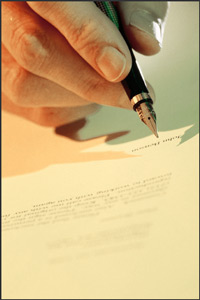Home | Glossary | Resources | Help | Contact Us | Course Map
Archival Notice
This is an archive page that is no longer being updated. It may contain outdated information and links may no longer function as originally intended.
Written Communications
Good communicators are rarely at a loss for words. However, even the most gifted has an innate preference for speaking or writing. Regardless of your proclivities, organizing your thinking before putting pen to paper requires considerably more time and effort than arranging your thoughts for a speaking engagement covering the same material. This belief makes sense if you consider that most people spend significantly more time talking than they do writing reports. Further, our conversations typically align more closely with our thoughts, which occur nearly constantly. The informal phrasing and expressions commonly used while speaking are deemed inappropriate for writing, demanding the use of exceptional language. Finally, most professionals (other than writers) believe that writing is a means to an end rather than a skill to be developed and perfected over time. As a result, we only engage in technical writing when necessary.
Nevertheless, there are some general guidelines that may help organize your thoughts. The first is to begin with the takeaway what is it that you want your audience to remember when they finish your report? If the list is longer than three broad items, you will need to pare them down to a manageable number. Additionally, be wary of setting your sights on specific postures or radical changes of opinion. Neither is likely unless your audience is highly motivated or easily influenced. Instead, boil your material down to its essence that can be articulated in a few short phrases that are effortlessly remembered. If you seek a modification of beliefs, concentrate on having them question the veracity of their positions, resulting in partial movement in the direction of interest. Finally, look for an opening discussion that captures their attention and causes them to want more and select closing arguments that reinforce your primary opinions.
Creating an Extended Outline
The extended outline is a favorite of many introductory writing teachers. It requires authors to examine the logic of their arguments and to think through the details of their focal ideas. Such outlines necessitate consideration of the relative importance of the various components of papers and how each portion relates to the others.
The best starting point is to take the opening and closing determined during the previous step and put the takeaway somewhere in the middle. Starting at the beginning, authors might list supporting information in the order in which it should be presented until the major thesis is revealed. Make sure that each item builds on the earlier material and that it supports the content to follow. Once the takeaway is properly determined, the remainder of the text can be used to address possible objections, to provide additional supporting material in the form of examples, and/or to discuss unique and valuable applications.
Turning Thought into Prose
Once the outline is complete, the next stage involves taking the ideas embedded within this structure and turning them into headings, subheadings, and text. Typically, the headings flow easily from the outline, which is most likely a listing of general themes. The difficult part is using these few words to generate coherent sentences and paragraphs that properly present your information and major theses. As noted earlier, the dilemma is translating thoughts into words in a fashion (written) that is different from the way we usually articulate what is on our minds. This process is akin to speaking in a foreign language where an individual must take an idea that arises in a native language, translate it into a second or third language, and present it verbally using the right pronunciations. With time and practice our abilities improve, but we rarely reach the point where technical reports flow with an ease consistent with our desires.
A way of avoiding this dilemma is to use the proverbial bullet points that are somewhere between individual words and text. Their judicious use within a well-written paper can draw attention to important items, but their overuse may lead to burnout by readers who have a hard time ferreting out what is important within these endless lists. A better approach is to rely more heavily on cogent paragraphs to capture and transmit meaning. A good starting place is to take every subheading and write one or a series of short paragraphs that contain all the supporting material and position statements you would like to convey about that topical area. Write as the ideas come naturally, recognizing that their translation into proper grammar and structure can occur at a later stage. Make sure that each paragraph has a clear yet interrelated beginning and ending, with its unique contribution accurately portrayed and highlighted in the text.
Flow and Style
The issue of flow of material poses difficulties for many writers of technical information. One problem is we tend to think that each topic is separate and apart from the whole, concentrating our efforts on communicating each item individually. This problem is exacerbated by the use of multiple authors who are experts on various portions but have no concept of the other issues. The simplest resolution to this difficulty may be to have one author or an outside editor work on the connections among sections of the document. Smooth transitions between major headings often summarize what has been said and set the stage for the information to come. To the extent possible, creating some excitement and anticipation that causes readers to want to continue reading is optimal. Remember the articles and books (including fiction) that best captured your attention. For the most part, these pieces were stimulating, comprehensible, and compelling.
Style Considerations and Editing
Technical writing may seem the antithesis of style, but that does not mean readers ask less of your documents. Stylistic considerations include many of the issues mentioned previously and require writers or editors to consider clarity of major points, flow within and among key sections and topics, and readability to lay audiences. Flowery language and verbosity are inappropriate, but too terse a presentation may leave readers wanting. A larger problem is reliance upon scientific idioms that are well know within the professional domain but are off-putting to persons who do not share the same academic background. Thus, the individual who works on flow can also edit the manuscript for a common and consistent use of language that is appropriate to your audience. A much-used tactic to support this process is to have people outside the boundaries of the profession read the material and give additional feedback about clarity, flow, and readability.
Closing Remarks
Providing scientific opinions in courts of law requires many of the same verbal and written tactics described previously with few modifications. For example, the content and format of the report may be determined by external quality organizations and laboratory procedures, which may require you to write in a manner that is not best for communicating your points of view. You may also be attempting to communicate in an environment that severely limits your ability to control your presentation. For example, you may be asked to respond to complex questions with either a yes or no response. Likewise, while judicious use of visual material can reinforce messages and serve to break up the monotony of scientific jargon, you must be aware that the court may not allow it.
Additionally, you may be required to communicate under a range of circumstances. Typically these are preliminary communications, depositions, court testimony, and the written report. For example, the first interaction in forensic firearm and toolmark cases generally occurs during preliminary communication with investigators and prosecutors. These communications are principally verbal and may seem informal. Be aware that the person you are talking to will selectively hear your comments and record them subjectively without qualification. In many jurisdictions, the next communication may be in the context of depositions. The deposition is a written record of your verbal statements and another instance when you will have to deal with contrasting requirements for effective verbal and written communications. Direct and cross-examination during court testimony are entirely verbal, but you have no control over the questions and frequently have limited control over how you can express your responses. Thus, apart from laboratory procedures, the written report is the only communication method that is entirely under your control.
Continuous Improvement
Much like getting to Carnegie Hall in New York City, the only way to improve communication skills is through practice. However, the quality of our practice makes a significant difference. Each of the previous topics provides advice on how to become a better speaker or writer. For verbal presentations, communicators are urged to know the background, interest level, diversity, and size of their audience before preparing talks. The use of visual materials should be designed to complement major points rather than direct attention away from presenters. Body language, gestures, and movement help engage and sustain your audience, along with the appropriate use of voice intonations and inflections. Written documents typically ask more of communicators, but technical writing need not be bland or boring. Writers also must consider audience traits as well as the logic of their presentations and the clarity and compelling nature of their prose.
One option for charting your improvement is through the use of a communications log. Using this device, communicators maintain a written diary of each and every time they present their ideas verbally or in writing to their professional colleagues. The log is best kept in an electronic form or spreadsheet. While people differ in the columns they prefer, examples include day, date, time of the day (to see if your performance varies by time), intended audience (to see if you are better with small or large/professional or lay audiences), length of presentation (to see if you fade in the long run or just hit your stride), type of presentation (to see if verbal or written forms differ), self-perceptions (to see if you believe things went well or poorly), others-perceptions (to see if the audience agrees), and lessons learned (to see what you can do differently or the same next time). Remember that growth in your abilities only occurs through some form of reflection!
Additional Online Courses
- What Every First Responding Officer Should Know About DNA Evidence
- Collecting DNA Evidence at Property Crime Scenes
- DNA – A Prosecutor’s Practice Notebook
- Crime Scene and DNA Basics
- Laboratory Safety Programs
- DNA Amplification
- Population Genetics and Statistics
- Non-STR DNA Markers: SNPs, Y-STRs, LCN and mtDNA
- Firearms Examiner Training
- Forensic DNA Education for Law Enforcement Decisionmakers
- What Every Investigator and Evidence Technician Should Know About DNA Evidence
- Principles of Forensic DNA for Officers of the Court
- Law 101: Legal Guide for the Forensic Expert
- Laboratory Orientation and Testing of Body Fluids and Tissues
- DNA Extraction and Quantitation
- STR Data Analysis and Interpretation
- Communication Skills, Report Writing, and Courtroom Testimony
- Español for Law Enforcement
- Amplified DNA Product Separation for Forensic Analysts




